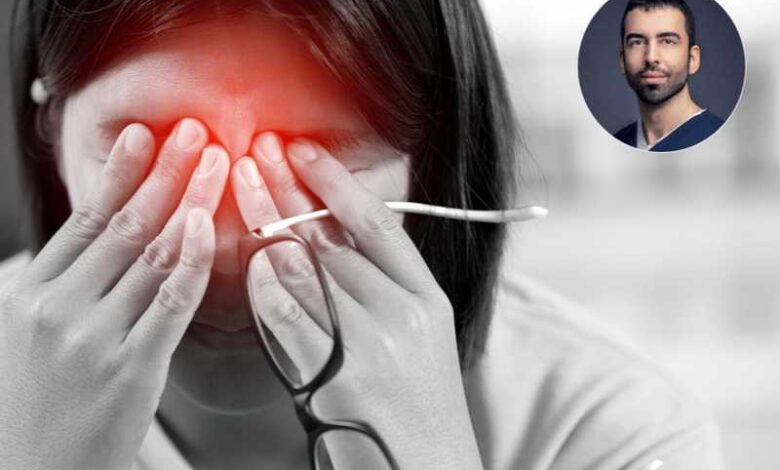
As we age, many of us experience changes in our vision, particularly when it comes to reading newspapers or messages on our phones. The need to enlarge font sizes becomes increasingly common, signaling a decline in eyesight. This phenomenon, known as presbyopia, can pose challenges, especially for those whose work requires prolonged computer use.
Dr. Muhammad Jassim Sadiq, a specialist in ophthalmology and surgery, explains that presbyopia is a natural consequence of aging, typically manifesting after the age of forty. It involves a gradual loss of the eye’s ability to focus on nearby objects, which worsens over time. Symptoms of presbyopia develop gradually and may include:
- Keep the newspaper away from the eyes so that the letters become clearer.
- Blurred vision at the normal near reading distance.
- Headache after reading or looking at the computer closely.
- Difficulty seeing and reading in dim lighting.
- The symptoms mentioned may worsen if you are tired.
The difference between nearsightedness and farsightedness
Dr. Sadiq emphasizes the importance of understanding the differences between presbyopia, myopia, and farsightedness. He describes the normal vision process, where light passes through the cornea and focuses precisely on the lens of the eye, resulting in a clear image on the retina. However, in myopia, the image is focused in front of the retina, causing close objects to appear clear while distant objects appear blurred. Conversely, in farsightedness, the image is focused behind the retina, resulting in clear vision of distant objects but blurriness when viewing nearby objects.
Understanding these distinctions can help individuals better comprehend their vision changes and seek appropriate treatment for conditions such as presbyopia.
Causes of myopia
Dr Sadiq explained. It is true that the causes of myopia are divided into two parts:
- Natural myopia: Its causes can be divided into two types: the first is physiological, and this is one of the natural developments of the eye that begins at birth and is characterized by a healthy lens and cornea shape. At birth, the child is farsighted, and as he reaches the first decade, farsightedness develops into nearsightedness. Vision stabilizes during the second decade of life (about 16-17 years), where the degree of myopia ranges from one person to another between 1.5 to 6 degrees. The second reason is aging, as age is accompanied by changes in the shape of the eye lens, and there is a possibility that water may form in the nucleus of the lens (cataract).
- Pathological myopia: any pathological changes in the shape of the cornea, lens, or focal length of the eye.
Regarding the causes of corneal changes, Dr Sadiq said it is true that there are two factors for this:
- Genetic or genetic factors: the presence of genes that cause congenital disorders in the shape of the cornea, such as keratoconus, corneal ectasia, and others.
- Acquired factors: causes that are not related to genes or congenital problems, such as: rheumatism, diabetes, diseases that cause problems in the arteries and blood flow, and exposure to injuries and accidents.
Treatment options
Dr Sadiq says treatments for physiological myopia include the following:
- Wearing medical glasses
- Wearing medical contact lenses
- Undergoing a laser procedure using PRK technology
- Place rings under the cornea
- Implanting the appropriate lens during the operation, such as ICL lenses and phakic IOLs
- If the eye is affected by cataracts or cataracts, the patient may need surgery to remove the waters with an IOL implantation.
Regarding the treatment of pathological myopia, Dr Sadiq says: Treatment options generally include:
- Wearing glasses or contact lenses
- Performing types of surgical procedures such as implanting ICL lenses or removing the entire lens and replacing it with a new lens.
- Performing classic corneal operations to correct vision using laser, LASIK or SMILE techniques.
Meanwhile, Dr Sadiq stressed the importance of educating people with myopia due to genetic problems such as keratoconus, indicating that classical vision correction operations such as (LASIK and SMILE) do not benefit them, as these cases require specialized operations on the cornea, and their type depends on the thickness, convexity, and severity of the patient’s myopia.
3 factors that accelerate the development of myopia
Dr. Sadiq indicated myopia develops on its own, either as part of eye development or as a result of pathological factors, but some things may cause a rapid deterioration in the severity of myopia, either temporarily or permanently, such as:
- Looking at close objects for a prolonged period, such as prolonged looking and reading on television screens, smart devices, and books (more than an hour without rest), as this accelerates the deterioration of eyesight, and may cause temporary nearsightedness.
- Excessive eye scrubs, allergies, and eye inflammation may cause changes in the cornea, especially keratoconus.
- Severe changes in hormones may cause visual deterioration in males and females during puberty, and in women during pregnancy and menopause.
Dr Sadiq said reading glasses sold in pharmacies are useful, but it is necessary to pay attention to their number and determine what is appropriate for the person according to his age and condition.













